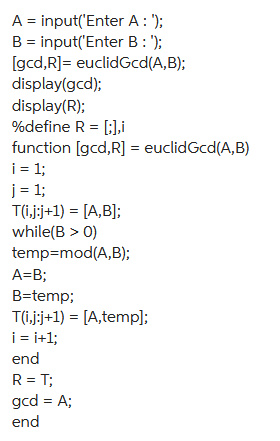(Euclidean Algorithm) As mentioned in class, the Euclidean algorithm is useful for finding the GCD of two numbers A and B by producing the sequence R, by R1 = mod (A, B), R2 = mod (B, Ry), R, = mod (R„ 2, Rµ 1) for n > 2. The last non-zero number in the sequence is the GCD of A and B. euclid_gcd Function: Input variables: • a scalar representing A • a scalar representing B (which you may assume is not equal to A) Output variables: • a scalar representing the GCD of A and B • a vector of all iterates produced (this vector should include R1 and R2 as its first entries as well as the final zero entry) A possible sample case is: » [GCD, R] = euclid_gcd(32, 40) GCD = 8 R = 32 8 0 » [GCD, R] = euclid_gcd(100, 65) GCD = 5 R = 35 30 5 0
(Euclidean Algorithm) As mentioned in class, the Euclidean algorithm is useful for finding the GCD of two numbers A and B by producing the sequence R, by R1 = mod (A, B), R2 = mod (B, Ry), R, = mod (R„ 2, Rµ 1) for n > 2. The last non-zero number in the sequence is the GCD of A and B. euclid_gcd Function: Input variables: • a scalar representing A • a scalar representing B (which you may assume is not equal to A) Output variables: • a scalar representing the GCD of A and B • a vector of all iterates produced (this vector should include R1 and R2 as its first entries as well as the final zero entry) A possible sample case is: » [GCD, R] = euclid_gcd(32, 40) GCD = 8 R = 32 8 0 » [GCD, R] = euclid_gcd(100, 65) GCD = 5 R = 35 30 5 0
Advanced Engineering Mathematics
10th Edition
ISBN:9780470458365
Author:Erwin Kreyszig
Publisher:Erwin Kreyszig
Chapter2: Second-order Linear Odes
Section: Chapter Questions
Problem 1RQ
Related questions
Question
make mathlab code
![**Euclidean Algorithm**
The Euclidean algorithm is useful for finding the GCD (greatest common divisor) of two numbers \( A \) and \( B \) by producing the sequence \( R_n \) as follows:
- \( R_1 = \text{mod} (A, B) \)
- \( R_2 = \text{mod} (B, R_1) \)
- \( R_n = \text{mod} (R_{n-2}, R_{n-1}) \), for \( n \ge 2 \).
The last non-zero number in the sequence is the GCD of \( A \) and \( B \).
**euclid_gcd Function:**
- **Input variables:**
- A scalar representing \( A \).
- A scalar representing \( B \) (which you may assume is not equal to \( A \)).
- **Output variables:**
- A scalar representing the GCD of \( A \) and \( B \).
- A vector of all iterates produced (this vector should include \( R_1 \) and \( R_2 \) as its first entries as well as the final zero entry).
**Sample Cases:**
1. **Case 1:**
```
>> [GCD, R] = euclid_gcd(32, 40)
GCD = 8
R =
32 8 0
```
2. **Case 2:**
```
>> [GCD, R] = euclid_gcd(100, 65)
GCD = 5
R =
35 30 5 0
```](/v2/_next/image?url=https%3A%2F%2Fcontent.bartleby.com%2Fqna-images%2Fquestion%2F36268169-052e-482b-acb5-c5dcae700f3f%2F71e95841-b1b7-4056-92fa-a3ba4a505f52%2F8vnhgh4_processed.png&w=3840&q=75)
Transcribed Image Text:**Euclidean Algorithm**
The Euclidean algorithm is useful for finding the GCD (greatest common divisor) of two numbers \( A \) and \( B \) by producing the sequence \( R_n \) as follows:
- \( R_1 = \text{mod} (A, B) \)
- \( R_2 = \text{mod} (B, R_1) \)
- \( R_n = \text{mod} (R_{n-2}, R_{n-1}) \), for \( n \ge 2 \).
The last non-zero number in the sequence is the GCD of \( A \) and \( B \).
**euclid_gcd Function:**
- **Input variables:**
- A scalar representing \( A \).
- A scalar representing \( B \) (which you may assume is not equal to \( A \)).
- **Output variables:**
- A scalar representing the GCD of \( A \) and \( B \).
- A vector of all iterates produced (this vector should include \( R_1 \) and \( R_2 \) as its first entries as well as the final zero entry).
**Sample Cases:**
1. **Case 1:**
```
>> [GCD, R] = euclid_gcd(32, 40)
GCD = 8
R =
32 8 0
```
2. **Case 2:**
```
>> [GCD, R] = euclid_gcd(100, 65)
GCD = 5
R =
35 30 5 0
```
Expert Solution
Reqiured matlab code

Step by step
Solved in 2 steps with 2 images

Recommended textbooks for you

Advanced Engineering Mathematics
Advanced Math
ISBN:
9780470458365
Author:
Erwin Kreyszig
Publisher:
Wiley, John & Sons, Incorporated

Numerical Methods for Engineers
Advanced Math
ISBN:
9780073397924
Author:
Steven C. Chapra Dr., Raymond P. Canale
Publisher:
McGraw-Hill Education

Introductory Mathematics for Engineering Applicat…
Advanced Math
ISBN:
9781118141809
Author:
Nathan Klingbeil
Publisher:
WILEY

Advanced Engineering Mathematics
Advanced Math
ISBN:
9780470458365
Author:
Erwin Kreyszig
Publisher:
Wiley, John & Sons, Incorporated

Numerical Methods for Engineers
Advanced Math
ISBN:
9780073397924
Author:
Steven C. Chapra Dr., Raymond P. Canale
Publisher:
McGraw-Hill Education

Introductory Mathematics for Engineering Applicat…
Advanced Math
ISBN:
9781118141809
Author:
Nathan Klingbeil
Publisher:
WILEY

Mathematics For Machine Technology
Advanced Math
ISBN:
9781337798310
Author:
Peterson, John.
Publisher:
Cengage Learning,

